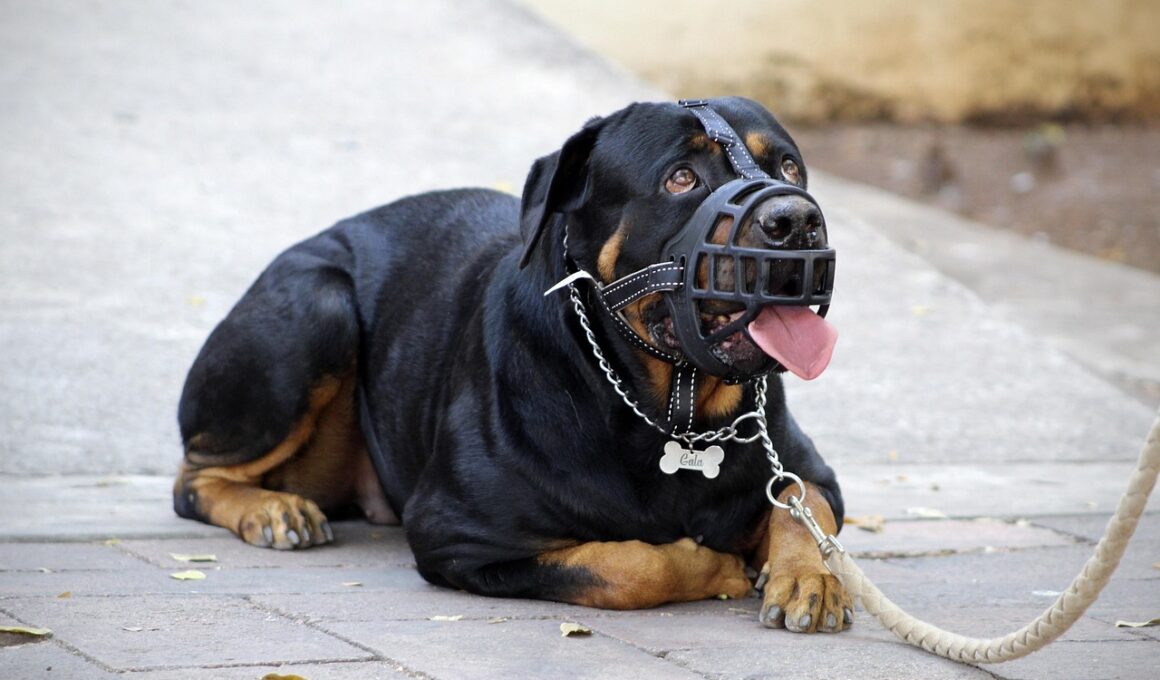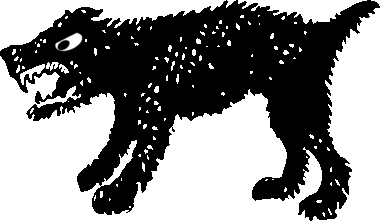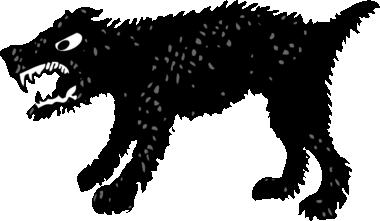Handling Fear-Based Aggression Safely
Fear-based aggression in dogs can pose a significant challenge for pet owners. Understanding the motivations behind such behavior is essential for safe management. Dogs may react aggressively when they feel threatened, scared, or anxious. This can include growling, barking, or even lunging at perceived threats. Often, this erratic behavior stems from past negative experiences, lack of socialization, or genetic predisposition. Owners must remain calm and consistent while addressing these troubling behaviors. A trustworthy environment can help diminish the dog’s fears, allowing for successful reconditioning. Furthermore, it’s essential to recognize early warning signs of stress in your dog. Common signs include raised hackles, avoidance, or excessive panting. Such behaviors can indicate a predisposition to aggression and must be addressed immediately. If these signs are ignored, they may escalate to growling or snapping. Using positive reinforcement training techniques helps create a more balanced relationship between owner and dog. Gradually exposing the dog to stimuli that provoke fear can help desensitize them over time. It’s important to seek professional help if the aggression persists, as behavior specialists have the tools to navigate these issues effectively.
Establishing a safe space for your dog is crucial when managing fear-based aggression. A designated area in your home where your dog feels secure can help mitigate anxious responses. This space can be a specific room or a crate where your dog can retreat when feeling overwhelmed. Adding familiar items like toys and blankets can enhance this environment, making it feel comforting. If your dog exhibits aggressive behavior towards visitors or other animals, it can be beneficial to introduce them gradually. Begin by allowing your dog to observe from a distance, creating a boundary that protects them without overwhelming them. Utilize positive reinforcement methods, rewarding calm behavior with treats or praise. This reinforces the idea that new experiences or visitors are not threats. Consistency in training is paramount; practice regularly to maintain the progress made. Body language is also vital; recognizing your dog’s signals can prevent escalation. Additionally, seeking veterinary advice may be necessary, as underlying medical issues can contribute to aggression. Medication may complement behavioral techniques, reducing anxiety levels. Taking these steps can lead to improved behavior and a more harmonious life with your dog.
The Importance of Socialization
Socialization is a key factor in preventing and managing fear-based aggression. Dogs that lack exposure to diverse environments, people, and other animals may develop fears that can manifest aggressively. Early socialization, particularly during the critical developmental period, can foster positive experiences that build confidence. Enrolling your dog in training classes or puppy socials can provide essential opportunities for safe interactions. Gradual exposure to various sights, sounds, and situations helps your dog acclimate, reducing fear responses over time. Positive reinforcement must be utilized during these experiences, as it associates new stimuli with rewards. When introducing your dog to other dogs, it’s best to do so in controlled environments where both parties are calm. Monitor their interactions closely, intervening if signs of stress start to appear. Encouraging play with well-adjusted dogs can also help your dog learn appropriate behaviors. Tools like muzzles can be used as a precaution in potentially stressful situations, ensuring safety while providing a space for learning. The investment in proper socialization yields lasting benefits, significantly reducing aggressive tendencies and promoting a well-rounded companion.
Another vital aspect of handling fear-based aggression is understanding your dog’s triggers. Identifying specific situations, objects, or experiences that cause distress is integral to a corrective strategy. Each dog is unique, and their responses can vary widely. Common triggers can include loud noises, unfamiliar people, or specific animal types. Once you’ve identified these triggers, maintaining a distance during situations that provoke fear is essential during the initial stages of training. You can gradually introduce those triggers at a safe distance, rewarding your dog for calm behavior. Keeping observation records of your dog’s reactions can help refine your approach. Always remember to remain composed when your dog is reacting aggressively; your behavior influences how they perceive their environment. Distractions can be effective in diffusing tense situations; bringing along high-value treats or toys can help redirect their focus. When appropriate, providing a safe space for your dog to retreat can alleviate stress and aggression. There are also various calming products available, from anxiety wraps to pheromone diffusers, that may aid in creating a more relaxed environment. This holistic approach is key to overcoming fear-based aggression efficiently and safely.
Professional Support and Training
When dealing with fear-based aggression, professional support can be an invaluable resource. Qualified trainers or behaviorists bring specific expertise in assessing and modifying aggressive behavior. They can develop customized training plans tailored to your dog’s unique needs. Additionally, they can assist in identifying underlying issues that may be contributing to fear-based reactions, which can sometimes be complex. Learning from professionals can provide pet owners with enhanced awareness of dog behavior. Classes focused on aggression management often incorporate behavior modification techniques that are humane and effective. Furthermore, trainers usually emphasize patience and consistency in training, which are essential for long-term success. Many trainers utilize positive reinforcement strategies, reinforcing desirable behaviors instead of punishing undesirable ones. Dog owners must avoid using aversive training methods, which can exacerbate fear and aggression. Attending behavior workshops or seminars can also be helpful for owners seeking to deepen their understanding of canine aggression. Evaluating different training philosophies can help in finding the right fit for you and your dog. Through collaborative efforts with professionals, pet owners can foster a better relationship with their dogs, reducing aggression over time.
Monitoring your dog’s progress throughout the training process is essential. Tracking changes in behavior helps you recognize patterns and adapt your approach when needed. Keep a journal that details training sessions, noting triggers, responses, and successes. This will give you insights into what works best for your dog and help you celebrate their achievements. Consistent practice is required to reinforce learning; gradually increasing exposure to triggers can aid in desensitization. If your dog displays setbacks, review your approach and consult with a professional for guidance. Training is not a linear process; many dogs experience ups and downs as they learn. Maintain realistic expectations and provide plenty of encouragement throughout the journey. Participate in support groups with other dog owners; sharing experiences can offer new insights and support. When a breakthrough occurs, it’s vital to reward your dog for their progress—a simple praise or treat can significantly boost their confidence. Placing focus on positive interactions will create a supportive atmosphere for learning. Practicing patience and commitment will eventually produce noticeable results. Your dog can lead a fulfilling life free from fear-based aggression with dedication.
Creating a Safe Environment
A safe environment plays a pivotal role in managing and reducing fear-based aggression in dogs. Home should be a haven where your dog feels comfortable and secure. Introducing calming elements like appropriate bedding, secure fencing, and distance from areas that trigger anxiety is vital. This space should be consistent and free from chaotic activities that may heighten stress. When introducing new experiences or training exercises, start in a low-stress environment. This allows your dog to acclimate to changes at a manageable pace. Providing structure in daily activities can also create a sense of security for your dog. Regular feeding times, exercise, and play sessions establish predictability in your dog’s life. Furthermore, avoiding overwhelming social situations can prevent anxiety-induced aggression. Gradually desensitizing your dog to various stimuli within the safe confines of your home can prepare them for future encounters. Consider implementing calming routines before potentially anxious situations to help decrease stress levels. Supplemental tools, such as calming music or pheromone diffusers, can enhance your dog’s comfort level. A safe environment reduces the likelihood of aggressive reactions and encourages positive behavior.
By implementing strategies for handling fear-based aggression, pet owners can foster a positive change in their dogs. Overall, patience, understanding, and proactive measures are crucial components of navigating these challenges. Training is a lifelong commitment, requiring a consistent approach and willingness to adapt as circumstances change. Encouraging communication between owners and dogs is pivotal to building trust. As your dog gains confidence, their aggression can decrease significantly. Stay focused on reinforcing desired behaviors and maintain realistic expectations throughout the training process. Celebrate small successes along the way, as they indicate progress. This journey can be demanding yet rewarding when undertaken with love and commitment. By employing effective training techniques, developing safe environments, and seeking professional support when necessary, you can transform fear-based reactions into positive behaviors. Every effort expended contributes positively towards enhancing the mental well-being of your dog. Moreover, these strategies promote a deeper bond and connection between you and your furry companion. Ultimately, fear-based aggression can improve through the right practices, leading to a happier and healthier life for your dog and peace of mind for you.





